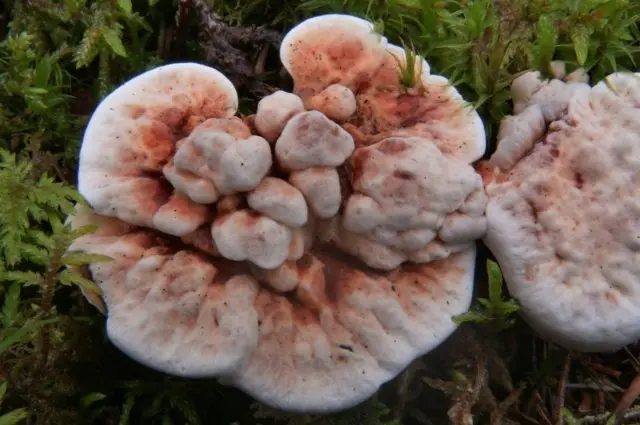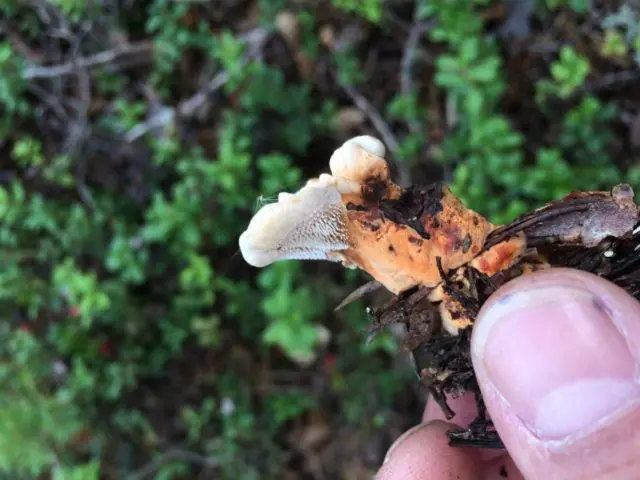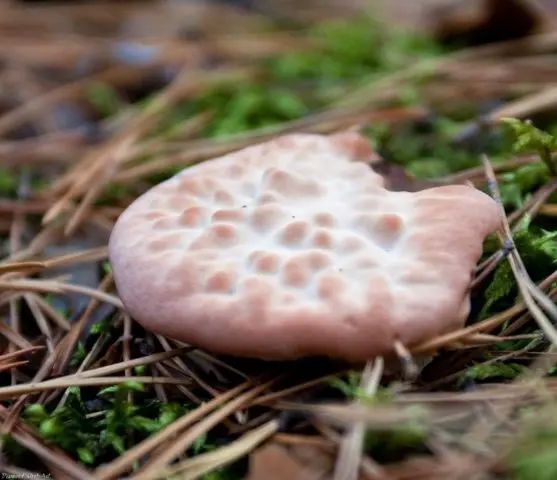Contents
Gidnellum orange belongs to the Banker family. The Latin name is Hydnellum aurantiacum.
What does hydnellum orange look like?

The taste and smell of the pulp depends on the growing conditions of the fungus.
The fruit body of this species is annual and quite large. Hydnellum orange can be recognized by the following parameters:
- The hat is 5 to 15 cm across. At the initial stage of development, it is white or cream in color, as it matures, it acquires orange or brown hues, while the edges remain light. The surface is radially wrinkled, initially velvety to the touch, but gradually becomes bare with irregularly shaped outgrowths of various sizes.
- Under the cap are spines descending to the leg, up to 5 mm long. In young mushrooms, they are painted white, with age they become brown. Spores are rough, almost spherical, light brown in color.
- The leg is cylindrical, central or shifted to the side, 2-5 cm long, and not more than 2 cm thick in diameter. The surface is felted, painted orange, becoming brown when growing. In the process of development, it absorbs and envelops a large number of litter fragments and living plants.
- The pulp is woody, hard, orange or light brown in color, in some specimens zonal. Information about the taste and smell of this variety varies considerably. So, some sources claim that this gift of the forest does not have a pronounced taste, but exudes a floury aroma, while others, on the contrary, mention an unexpressed smell, as well as a floury or bitter taste.
Where does hydnellum orange grow?
This species lives on soil in pine or mixed forests. Can grow singly or in groups. Favorable time for fruiting is the period from July to October. Quite common in the western part of Our Country.
Is it possible to eat hydnellum orange
The considered species belongs to the group of inedible mushrooms. Despite the fact that no toxic substances have been identified in it, orange hydnellum is not suitable for food due to its special hard pulp.
Similar species

During growth, wraps around obstacles encountered, such as needles, branches or live plants
Gidnellum orange in some ways is similar to the following relatives:
- Hydnellum golden – not suitable for food use. You can recognize the twin by smaller fruiting bodies, where the cap in diameter reaches up to 5 cm. In addition, the distinguishing feature from the described species is the golden-orange color of the spines and the evenly colored reddish flesh on the cut.

- Hydnellum rusty – belongs to the group of inedible mushrooms. At a young age, the cap is club-shaped, gradually acquires an obverse-conical shape, in some cases it can be flat or funnel-shaped. The surface is velvety, uneven, initially whitish in color, becoming pale chocolate or rusty brown as it matures.

Conclusion
Hydnellum orange is a kind of mushroom that can be found in the second half of summer and up to October in mixed and pine forests. This is an annual specimen, with large fruiting bodies of an unusual shape, which tend to grow together. It is not suitable for consumption, but it can be used to dye woolen things in green, brown or grayish shades.











